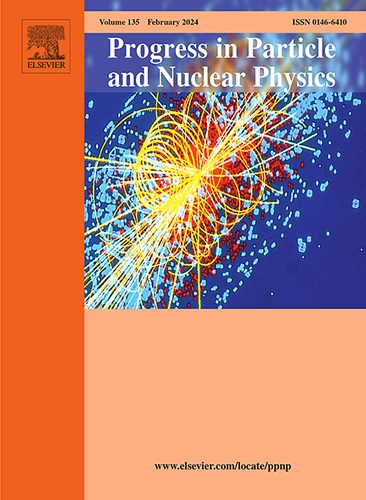扩展线性Sigma模型中的普通介子和奇异介子
IF 17.9
2区 物理与天体物理
Q1 PHYSICS, NUCLEAR
引用次数: 0
摘要
扩展线性西格玛模型(eLSM)是基于QCD的全局对称性和相应的显式、异常和自发破缺模式的强子模型。在其基本的三味形式中,它的介子部分包含膨胀/胶球以及伪标量、标量、矢量和轴矢量介子的粒子,从而线性实现手性对称。在手性极限和忽略手性异常的情况下,只有一个项在扩张势内打破了扩张不变性,所有项都是手性对称的。自发对称破缺是由墨西哥帽势的泛化实现的,其倾斜是由显式对称破缺引起的。高达~ 2 GeV的整体中频现象学与质量、部分和总衰变宽度的PDG汇编一致。eLSM以一种直接的方式扩大,包括其他传统的夸克-反夸克介子(伪矢量和轨道激发的矢量介子,张量和轴向张量介子,径向激发的(伪)标量介子等),以及两个混合介子的介子,最轻的具有奇异量子数JPC=1−+的介子,不允许在q q天体中存在,如共振π1(1600)和最近发现的η1(1855)。在此过程中,引入了不同类型的手性多胞胎:异手性多胞胎和同手性多胞胎,它们在手性变换下的变换方式不同。此外,除了从一开始就以膨胀子形式存在的标量胶球外,其他胶球、张量胶球、伪标量胶球和矢量胶球都与eLSM耦合:标量共振f0(1710)主要是胶子共振,张量胶球与矢量介子强烈耦合,伪标量胶球与ππη′有相当大的耦合,可以归属于X(2370)或X(2600)。在上述所有情况下,质量和衰变都可以进行分析,从而更好地理解传统和非常规介子:只要有数据,就进行比较,如果没有数据,就对衰变宽度和衰变比进行预测。eLSM包含相等基础上的手性伙伴,因此非常适合于研究非零温度和密度下的手性对称性恢复:这是通过将其耦合到Polyakov环来完成的。在此框架下研究了QCD相图和临界端点的位置。本文章由计算机程序翻译,如有差异,请以英文原文为准。
Ordinary and exotic mesons in the extended Linear Sigma Model
The extended Linear Sigma Model (eLSM) is a hadronic model based on the global symmetries of QCD and the corresponding explicit, anomalous, and spontaneous breaking patterns. In its basic three-flavor form, its mesonic part contains the dilaton/glueball as well as the nonets of pseudoscalar, scalar, vector, and axial–vector mesons, thus chiral symmetry is linearly realized. In the chiral limit and neglecting the chiral anomaly, only one term – within the dilaton potential – breaks dilatation invariance, and all terms are chirally symmetric. Spontaneous symmetry breaking is implemented by a generalization of the Mexican-hat potential, with explicit symmetry breaking responsible for its tilting. The overall mesonic phenomenology up to GeV is in agreement with the PDG compilation of masses and partial and total decay widths. The eLSM was enlarged in a straightforward way to include other conventional quark–antiquark nonets (pseudovector and orbitally excited vector mesons, tensor and axial-tensor mesons, radially excited (pseudo)scalar mesons, etc.), as well as two nonets of hybrid mesons, the lightest one with exotic quantum numbers not allowed for objects, such as the resonance and the recently discovered . In doing so, different types of chiral multiplets are introduced: heterochiral and homochiral multiplets, which differ in the way they transform under chiral transformations. Moreover, besides the scalar glueball that is present from the beginning as dilaton, other glueballs, the tensor, the pseudoscalar and the vector glueballs were coupled to the eLSM: the scalar resonance turns out to be mostly gluonic, the tensor glueball couples strongly to vector mesons, and the pseudoscalar glueball couples sizably to and can be assigned to or . In all cases above, masses and decays can be analyzed allowing for a better understanding of both conventional and non-conventional mesons: whenever data are available, a comparison is performed and, when this is not the case, predictions of decay widths and decay ratios are outlined. The eLSM contains chiral partners on an equal footing and is therefore well suited for studies of chiral symmetry restoration at nonzero temperature and densities: this is done by coupling it to the Polyakov loop. The QCD phase diagram and the location of the critical endpoint were investigated within this framework.
求助全文
通过发布文献求助,成功后即可免费获取论文全文。
去求助
来源期刊

Progress in Particle and Nuclear Physics
物理-物理:核物理
CiteScore
24.50
自引率
3.10%
发文量
41
审稿时长
72 days
期刊介绍:
Taking the format of four issues per year, the journal Progress in Particle and Nuclear Physics aims to discuss new developments in the field at a level suitable for the general nuclear and particle physicist and, in greater technical depth, to explore the most important advances in these areas. Most of the articles will be in one of the fields of nuclear physics, hadron physics, heavy ion physics, particle physics, as well as astrophysics and cosmology. A particular effort is made to treat topics of an interface type for which both particle and nuclear physics are important. Related topics such as detector physics, accelerator physics or the application of nuclear physics in the medical and archaeological fields will also be treated from time to time.
 求助内容:
求助内容: 应助结果提醒方式:
应助结果提醒方式:


